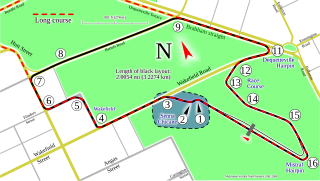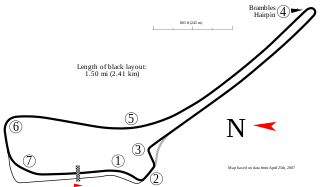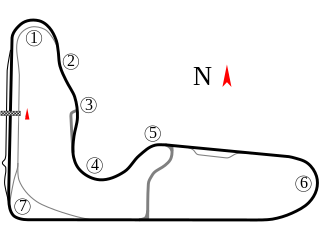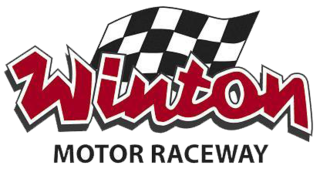
Craig Andrew LowndesOAM is an Australian racing car driver in the Repco Supercars Championship racing for Triple Eight Race Engineering. He is also a TV commentator.

The Adelaide 500 is an annual motor racing event for Supercars held on the streets of the east end of Adelaide, South Australia between 1999 and 2020 and again from 2022. The event uses a shortened form of the Adelaide Street Circuit, the former Australian Grand Prix track. The event is still colloquially known as the Clipsal 500 or simply "Clipsal" after its former longtime sponsor. By attendance and number of events, the Adelaide 500 is the biggest multiple-day car race in Australia.

Jamie Whincup is an Australian professional racing driver competing in the Supercars Championship. He currently is team principal for Triple Eight Race Engineering. He has driven the No. 88 Holden ZB Commodore, won a record seven Supercars championship titles, four Bathurst 1000 victories, and a Bathurst 12 Hour victory. Whincup is the all-time record holder in the Supercars Championship for race wins, at 125 career wins. He is also the first driver to win the Jason Richards Memorial Trophy twice at Pukekohe Park Raceway in Auckland, New Zealand.

The Sandown 500 is an annual endurance motor race which is staged at the Sandown Raceway, near Melbourne, Victoria, Australia from 1964. The event's name, distance – and the category of cars competing in it – has varied widely throughout its history. Most recently, the event was held as a championship event for Supercars from 2003 to 2007 and from 2012 to 2019.

The Tasmania SuperSprint is an annual motor racing event for Supercars, held at Symmons Plains Raceway in Launceston, Tasmania. The event has been a regular part of the Supercars Championship—and its previous incarnations, the Australian Touring Car Championship, Shell Championship Series and V8 Supercars Championship—since 1969.

The Grand Finale, also known as the V8 Ultimate and as The Main Event, was the auto race held as the final round of the V8 Supercar Championship Series from 2001 to 2008. In those years, it was held at Sandown Raceway, Eastern Creek Raceway, the Phillip Island Grand Prix Circuit and Oran Park Raceway.

The Perth SuperSprint is an annual motor racing event for Supercars, held at Wanneroo Raceway in Wanneroo, Western Australia. The event has been a regular part of the Supercars Championship and its predecessor, the Australian Touring Car Championship, since 1973.

The Phillip Island 500 was an annual motor racing event, last held for Supercars at the Phillip Island Grand Prix Circuit in Phillip Island, Victoria. The race had three distinct eras; from 1971 to 1977 as an endurance production and later Australian Touring Car Championship race, from 2008 to 2011 as an endurance race as part of V8 Supercars and from 2017 to 2018 as a Supercars Championship event consisting of two 250 km races.

The Sydney 500 was an annual motor racing event for Supercars, held at the Homebush Street Circuit in Sydney Olympic Park, New South Wales, Australia. The event was a regular part of the Supercars Championship from 2009 to 2016, being the final event on the calendar.

The Ipswich SuperSprint was an annual motor racing event for Supercars, held at Queensland Raceway near Ipswich, Queensland. The event was a regular part of the Supercars Championship—and its previous incarnations, the Shell Championship Series and V8 Supercars Championship—from 1999 to 2019.

The 2013 International V8 Supercars Championship was a Fédération Internationale de l'Automobile-sanctioned international motor racing series for V8 Supercars that was based in Australia. It was the fifteenth running of the V8 Supercar Championship Series and the seventeenth series in which V8 Supercars contested the premier Australian touring car title. The championship was contested over thirty-six races, starting with the Clipsal 500 Adelaide on 2 March 2013, and finishing with the Sydney 500 on 8 December. The series' calendar also expanded, travelling to the United States for the first time for a race at the Circuit of the Americas in Austin, Texas.

The Winton SuperSprint was an annual motor racing event for Supercars, held at Winton Motor Raceway in Winton, Victoria. The event has been a regular part of the Supercars Championship—and its previous incarnations, the Australian Touring Car Championship, Shell Championship Series and V8 Supercars Championship—between 1985 and 2022.

The 2014 International V8 Supercars Championship was an FIA-sanctioned international motor racing series for V8 Supercars. It was the sixteenth running of the V8 Supercars Championship and the eighteenth series in which V8 Supercars have contested the premier Australian touring car title.

The Sydney SuperNight is an annual motor racing event for Supercars, held at Sydney Motorsport Park in Eastern Creek, New South Wales. The event has been a semi-regular part of the Supercars Championship—and its previous incarnations, the Australian Touring Car Championship, Shell Championship Series and V8 Supercars Championship—since 1992. Since 2018, this is the only active Supercars event held in metropolitan Sydney.

The 2015 International V8 Supercars Championship was an FIA-sanctioned international auto racing series for V8 Supercars. It was the seventeenth running of the V8 Supercar Championship Series and the nineteenth series in which V8 Supercars have contested the premier Australian touring car title.

The 2016 International V8 Supercars Championship was an FIA-sanctioned international motor racing series for Supercars. It was the eighteenth running of the Supercars Championship and the twentieth series in which Supercars have contested the premier Australian touring car title.

The Supercars Challenge was an annual non-championship motor racing event held for cars from the Supercars Championship, and formerly from V8 Supercars, the Shell Championship Series and the Australian Touring Car Championship. The event was held on the Albert Park Circuit in Albert Park, Victoria, Australia as a support event to the Australian Grand Prix.

The Oran Park V8 Supercar round was a V8 Supercar, and formerly Australian Touring Car Championship, motor racing event held at Oran Park Raceway in Narellan, New South Wales, Australia. The event was held in every year from 1971 to 2008, with only three circuits having hosted more events in championship history as of 2020.

The 2019 Supercars Championship was the twenty-first running of the Supercars Championship and the twenty-third series in which Supercars have contested the Australian Touring Car Championship, the premier title in Australian motorsport. The 2019 championship also included the running of the 1,000th Australian Touring Car Championship race, which was contested at the Melbourne 400.

The Bathurst 500 is a Supercars Championship motor racing event that has been on occasion, with the most recent iteration scheduled for the 2024 season at Mount Panorama Circuit in Bathurst, New South Wales, Australia.


















